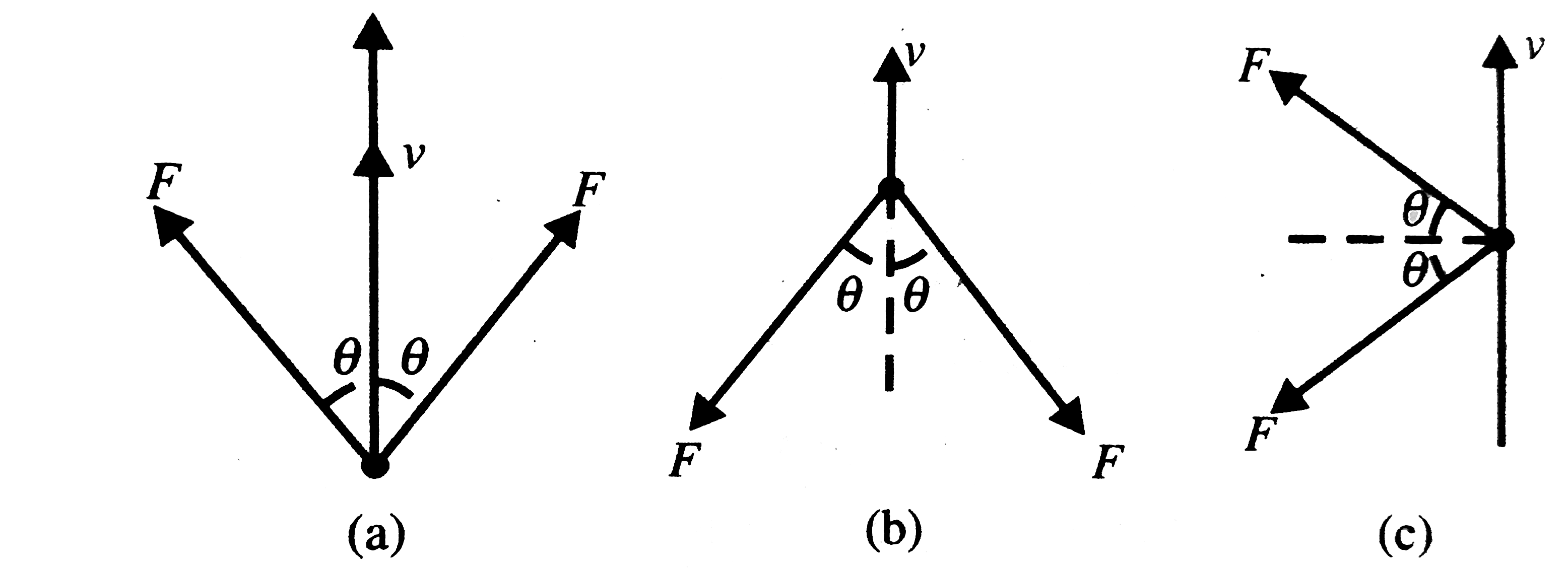A particle is acted upon by a force of constant magnitude which is always perpendicular to the velocity of the particle. The motion of the particle takes place in a plane. It follows that
its velocity is constant
its acceleration is constant
its kinetic energy is constant
it moves in a straight line.
The correct Answer is:C
To solve the problem step by step, we can follow this reasoning:
Step 1: Understand the nature of the force
The problem states that a particle is acted upon by a force of constant magnitude that is always perpendicular to the velocity of the particle. This means that the force does not do work on the particle since work done is given by the dot product of force and displacement.
Hint: Remember that when force is perpendicular to the direction of motion, it does not change the speed of the particle.
Step 2: Analyze the work done by the force
Since the force is perpendicular to the velocity, we can express this mathematically as:
F⋅v=0
This implies that the work done W by the force over any displacement is zero:
W=F⋅d=0
Hint: Recall that work done is related to the change in kinetic energy.
Step 3: Apply the work-energy theorem
According to the work-energy theorem, the work done on an object is equal to the change in its kinetic energy:
W=ΔKE=KEfinal−KEinitial
Since we established that the work done is zero, we have:
KEfinal−KEinitial=0
This implies:
KEfinal=KEinitial
Hint: Think about what it means for kinetic energy to remain constant.
Step 4: Conclude about the kinetic energy
Since the kinetic energy is constant, we can conclude that the speed of the particle does not change. However, the direction of the velocity can change due to the perpendicular force, leading to circular or curved motion.
Hint: Consider the implications of constant speed in terms of motion.
Step 5: Final conclusion
Thus, we conclude that the kinetic energy of the particle remains constant throughout its motion. Therefore, the correct answer to the question is that the kinetic energy is constant.
Final Answer: The kinetic energy is constant.
The problem states that a particle is acted upon by a force of constant magnitude that is always perpendicular to the velocity of the particle. This means that the force does not do work on the particle since work done is given by the dot product of force and displacement.
Since the force is perpendicular to the velocity, we can express this mathematically as:
F⋅v=0
This implies that the work done W by the force over any displacement is zero:
W=F⋅d=0
According to the work-energy theorem, the work done on an object is equal to the change in its kinetic energy:
W=ΔKE=KEfinal−KEinitial
Since we established that the work done is zero, we have:
KEfinal−KEinitial=0
This implies:
KEfinal=KEinitial
Since the kinetic energy is constant, we can conclude that the speed of the particle does not change. However, the direction of the velocity can change due to the perpendicular force, leading to circular or curved motion.
Thus, we conclude that the kinetic energy of the particle remains constant throughout its motion. Therefore, the correct answer to the question is that the kinetic energy is constant.
Topper's Solved these Questions
Similar Questions
A particle is acted upon by a force of constant magnitude which is always perpendiculr to the velocity of the particle. The motion of the particle takes place in a plane. It follows that
View SolutionA particle is acted upon by a force of constant magnitude which is always perpendiculr to the velocity of the particle. The motion of the particle takes place in a plane. It follows that
View Solution
Knowledge Check
- Question 1 - Select One
the circular motion of a particle with constant speed is
Aperiodic and simple harmonicBsimple harmonic but not periodicCneither periodic nor simple harmonicDperiodic but not simple harmonic
When the force of constant magnitude always act perpendicular to the motion of a particle then :
View SolutionThe magnetic force on a charged particle is always perpendicular to its velocity. Can the magnetic force change the velocity of the particle? Speed of the particle?
View SolutionA particle of mass m is acted on by two forces of equal magnitude F maintaining their orientation relative to the velocity v as shown in Fig. The momentum of the particle
 View Solution
View SolutionDescribe the motion of a particle acted upon by the force:
View SolutionA particle experience a force of 10 N which is constant in magnitude and is always acting towards origin. Calculate the work done by the force on the particle during its displacement from (1,2,3) to (−1,−2,3):
View SolutionA particle at rest on a frictionless table is acted upon by a horizontal force which is constant in magnitude and direction. A graph is plotted of the work done on the particle W, against the speed of the particle v. If there are no frictional forces acting on the particle, the graph will look like
View SolutionA particle initially at rest is subjected to two forces, one is constant, the other is retarding force proportional to the particle velocity. In the subsequent motion of the particle, the acceleration
View Solution

